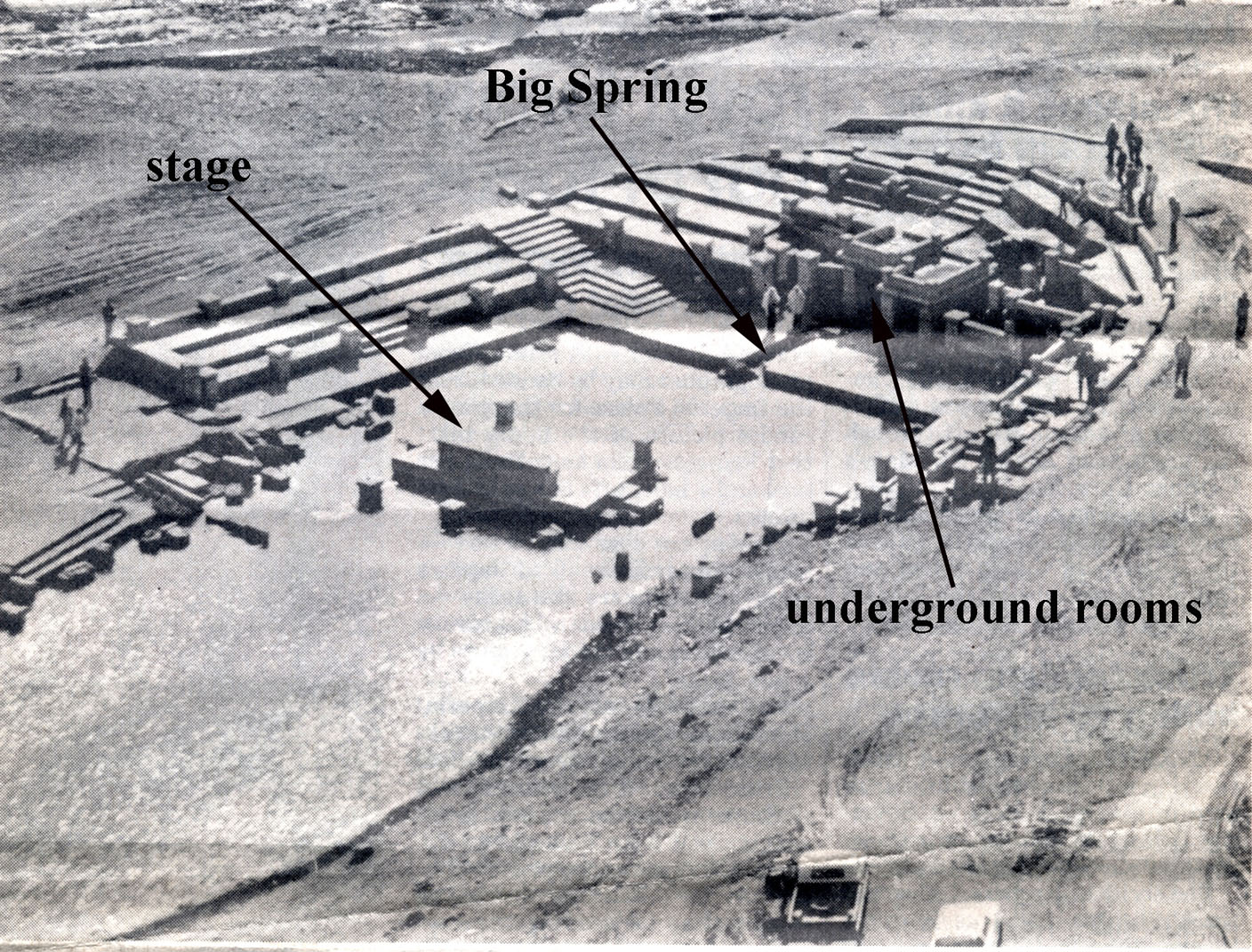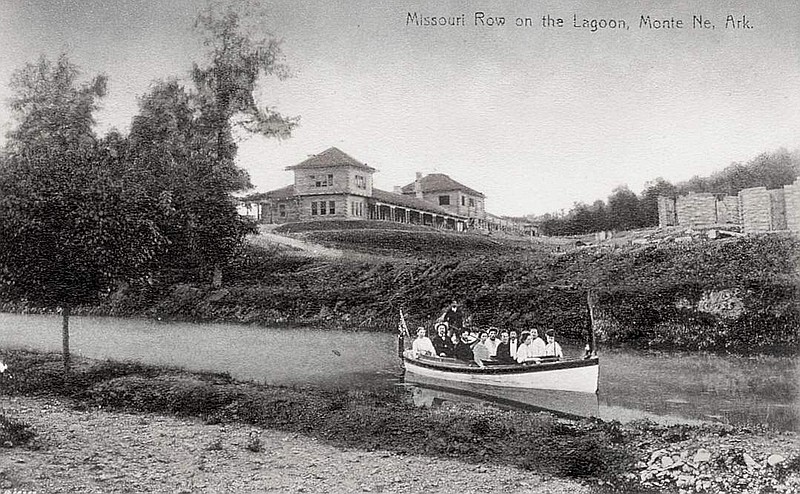The recent demolition of the tower and foundation of the Oklahoma Row Hotel has created a lot of interest in the lost town of Monte Ne. Folks who grew up in this area are familiar with the famous resort created by William "Coin" Harvey in the early 1900s. However, thousands of newcomers to Northwest Arkansas may not know the story.
An eccentric millionaire, Coin Harvey came to Rogers in 1900 and bought 320 acres of lush valley just four miles southeast of town. The valley had many springs, including one (Big Spring) that gushed forth 10,000 gallons of cool clear water per minute. Harvey dammed the flow from these springs to form a small lake and built his resort around it. He has been described as a prophet, a great visionary, a genius, a promoter, a flim-flam man, a planner, and a schemer. He had an ego that knew no limits, always aligned himself with the rich and powerful and had an incredible talent for convincing them to invest in his ventures.
He built three major hotels and the first heated swimming pool in Arkansas. He brought the railroad to his resort and built the depot. He imported a genuine gondola and gondolier from Italy for private romantic rides on his man-made lake. This was a tremendous feat, for the gondola had to be brought across the ocean by ship and then by rail to Monte Ne. There was a bowling alley, pool room, large auditorium, fish-stocked lake, and the first golf course in Northwest Arkansas.
In 1904, he brought an architect, A.O. Clarke, from St. Louis to design the rest of his resort, and together they built the Missouri Row Hotel, the Bank of Monte Ne, Oklahoma Row Hotel and other projects. Without realizing it, bringing Clarke to Rogers was the greatest of all of Harvey's accomplishments. Even though the resort had failed by 1914, A.O. Clarke remained and designed most of the major structures in Rogers from his office above the Stroud Mercantile building on Walnut Street. He also designed major buildings for Benton County and the surrounding area until his death in 1935.
That is a brief overview of Coin Harvey and his fabulous Resort of Monte Ne. Here are a few true tales that you may not have heard:
Coin Harvey's Gunfight
The construction of the resort was in full swing in 1905, and Harvey was building two large hotels simultaneously, the Club House Hotel and Missouri Row Hotel. In order to speed construction and keep down costs, the work crews were asked to work longer hours for the same amount of money. This didn't go over very well, and about 30 carpenters and stoneworkers went on strike, causing the infuriated Harvey to fire them.
The leader of the strikers confronted Harvey, and the following is an account of the fight in the May 31, 1905, Rogers Democrat. Keep in mind that Harvey was a small, slender, 53-year-old man.
"An altercation Saturday afternoon at Monte Ne between W.H. Harvey and W.J. Mallett came as a climax to the trouble Mr. Harvey has been having with the workmen at that place. Several references to Mr. Mallett in the last issue of the Monte Ne Herald were resented by that gentleman, and when he met Mr. Harvey, he demanded to know the author of them. Mr. Harvey assumed all responsibility, whereupon heated words passed between them. Mr. Harvey, who had been deputized as a special constable, was carrying a revolver in his belt. He states that Mr. Mallett struck him, and he attempted to draw the gun in self-defense. Mallett claims he did not strike Mr. Harvey until the latter tried to get the gun..." The gun was knocked to the ground in the ensuing struggle, and the fight ended. Mallett was a huge man, and his blows severely bruised Harvey, who spent several days in bed recovering. Charges were brought against both men, but they appear to have been dismissed later.
The construction of the Club House Hotel was abandoned, and all of the available non-striking workers were used to complete the Missouri Row Hotel. The foundation of the Missouri Row Hotel is always out of the water and can be explored. The remains of the Club House Hotel can be seen beside the boat ramp when the water level is low.
The Great Water Flume Ride
Everyone who has been to Silver Dollar City in Branson, Mo., has ridden or seen the American Plunge, where the passengers ride a boat shaped like a log down a steep flume and plunge into the pool below. Well, that is not an original idea, and Silver Dollar City may have been inspired by Coin Harvey. The following ad promoting Monte Ne ran in the Rogers Democrat on Feb. 2, 1902: "One of the greatest attractions the Ozark Mountains will possess is being constructed here. It is what is known as 'the shooting of the shoots' -- a flume water way carrying a boat and passengers down a heavy grade 600 feet long. It will be one of the novelties of the summer season." I don't know if the ride was a success or not, as I haven't seen it mentioned anywhere else during my research, but I would personally pay a lot of money to have been able to witness the spectacle.
Coin Harvey's Death Mask
"Otis McKinney, manager of the Callison Funeral Home on West Walnut Street in Rogers (in 1936), was the funeral director for Harvey's burial. It was bitterly cold when Harvey died, making it difficult to prepare his grave. While the embalmed body awaited entombment, McKinney made a death mask (actual mold of the deceased person's head) of the great man, believing that Harvey's features should be preserved. He kept the mask at the funeral home, showing it to friends but never putting it on display. Harvey's death mask is a remarkable work. Made of plaster of Paris and painted bronze, it captures every wrinkle, every vein, and every hair of the man in his final slumber... Harvey's death mask was the only one he (McKinney) is known to have created," according to Dr. Gaye Bland from the Rogers Historical Museum's website, 2009.
Harvey's death mask was donated by Carl McKinney -- brother of Otis McKinney -- and can be seen today at the Rogers Historical Museum.
The Treasure in the Pyramid
By 1920, the resort had failed, and Harvey became disillusioned. He thought our civilization was doomed, so in 1926, Harvey started his "great pyramid" project. His idea was to build a 140-foot concrete obelisk for the purpose of preserving the history of civilization. The pyramid was to be a time capsule containing all of the inventions and writings of the day. He believed that sometime in the distant future, mankind would return to Monte Ne, open the pyramid, and read about the reasons for the failure of civilization and avoid making the same mistakes.
The knoll that he chose on which to build the structure was on the bank of the lake across from the former train station and just a short walk to his home. To prevent the erosion of the rock on the north side of the pyramid and to provide an entrance to the pyramid, a huge concrete stadium or amphitheater was built.
Harvey put all of his remaining funds into the construction of the amphitheater, and it was finally completed in 1928. Harvey tried to raise funds to build the actual pyramid, but the Great Depression came in 1929, and the pyramid was never built. The amphitheater still exists today under Beaver Lake. It seated 1,000 people and has mysterious rooms and vaults underneath. The amphitheater has always been called "the pyramids" by local folks.
Even though the pyramid was never built, many folks claimed that there were artifacts and treasure and even a Model-T Ford encased in secret vaults in the amphitheater. W.T. McWhorter of Rogers owned the amphitheater when it was acquired by the Corps of Engineers for the construction of Beaver Lake. He was going to dynamite the structure in search for the hidden treasures on May 14, 1963, the last day before turning it over to the government. Hundreds of people gathered to witness the event. Thirty minutes before the scheduled explosion, the COE stopped the dynamiting, and the "pyramids" are still intact today, although under water most of the time. McWhorter said, "I am certain there were items buried in a vault... I've talked to people who helped seal it up." (Rogers Daily News, May 15, 1963) Does the treasure exist? No one knows, but most experts contend that artifacts were concealed in the amphitheater but never any real treasure.
 Coin Harvey's strangest project was the amphitheater or "the pyramids," as it is known by local folks. This photo from about 1963 is just before the flooding of Beaver Lake. The U.S. Army Corps of Engineers has removed the gift shop and cleaned up everything except the basic structure and stage. (Courtesy Photo/Rogers Historical Museum)
Coin Harvey's strangest project was the amphitheater or "the pyramids," as it is known by local folks. This photo from about 1963 is just before the flooding of Beaver Lake. The U.S. Army Corps of Engineers has removed the gift shop and cleaned up everything except the basic structure and stage. (Courtesy Photo/Rogers Historical Museum)